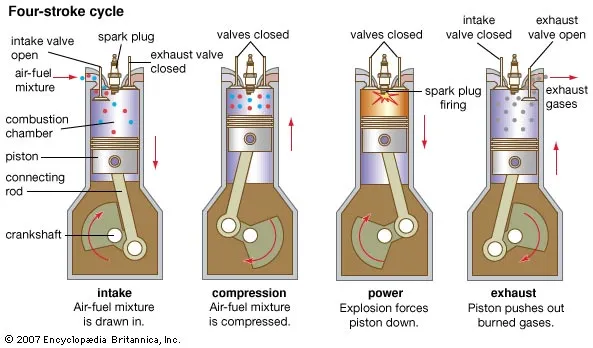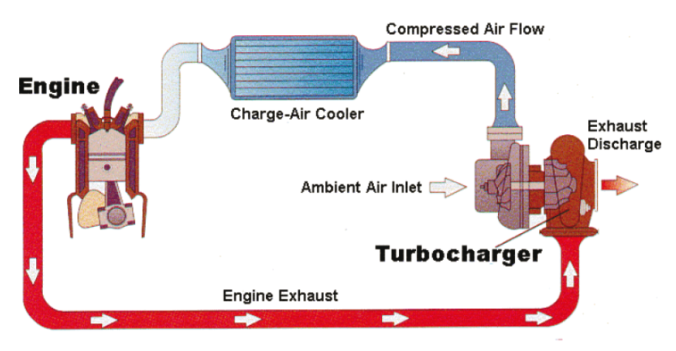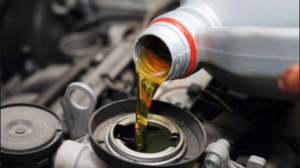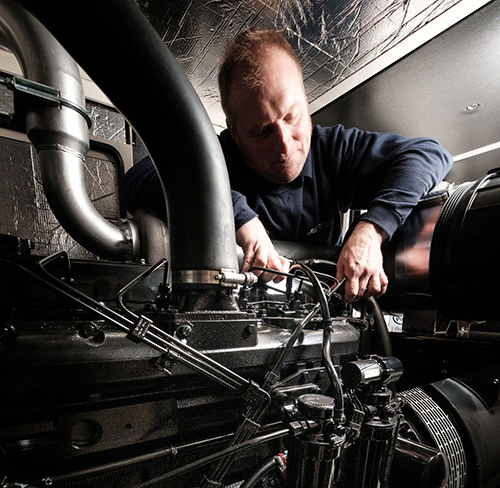A common misconception among users is that operating diesel generators at lower loads is beneficial. In reality, prolonged low load operation can cause significant harm to the generator’s components and overall performance.
This article explores the 5 major harms associated with operating diesel generators under low load conditions for extended periods: poor piston and cylinder liner sealing, carbon accumulation, turbocharger issues, increased lubricating oil consumption, and increased wear and tear on moving parts. Additionally, it provides preventive measures to mitigate these issues, ensuring the longevity and efficiency of diesel generators.
1. Poor Piston and Cylinder Liner Sealing:
Low load operation can cause poor sealing between the pistons and cylinder liners, allowing engine oil to enter the combustion chamber and burn, resulting in blue smoke emissions that pollute the air.

This problem arises due to the following factors:
1.1 Insufficient Combustion Pressure:
Diesel engines are designed to operate efficiently under specific load conditions, typically at or near full load. Under low load conditions, the combustion pressure is significantly reduced. This decrease in pressure can prevent the pistons from fully expanding and sealing against the cylinder walls, leading to poor sealing and increased blow-by.
1.2 Increased Blow-By:
Blow-by occurs when combustion gases escape past the piston rings and enter the crankcase. This not only reduces the engine’s efficiency but also introduces contaminants, such as unburned fuel and soot, into the engine oil. These contaminants can degrade the oil’s lubricating properties, leading to increased engine wear and tear.
1.3 Oil Leakage into the Combustion Chamber:
Poor sealing between the pistons and cylinder liners allows engine oil to bypass the piston rings and enter the combustion chamber. When this oil burns, it produces blue smoke, which is a clear indicator of oil consumption. The burning oil contributes to higher levels of exhaust emissions, including particulate matter and hydrocarbons, which are harmful to the environment.
1.4 Increased Wear and Tear:
The insufficient sealing increases friction between the pistons and cylinder walls, accelerating wear and tear. Over time, this can lead to scoring and pitting on the cylinder walls, further exacerbating the sealing issues and leading to costly repairs or even engine failure.
1.5 Carbon Deposits:
The burning of engine oil in the combustion chamber results in the formation of carbon deposits on the piston crowns, cylinder heads, and valves. These deposits can interfere with the engine’s normal operation, causing pre-ignition and knocking, which further reduce engine efficiency and increase the risk of damage.
1.6 Air Pollution:
Blue smoke resulting from oil burning is not only an indication of engine problems but also a significant contributor to air pollution. This smoke contains various harmful pollutants, including particulate matter and unburned hydrocarbons, which can have adverse effects on human health and the environment.
1.7 Impact on Engine Performance:
Poor sealing and increased blow-by reduce the engine’s overall efficiency and power output. The engine may struggle to achieve its rated performance, leading to increased fuel consumption and operating costs. Additionally, the engine may become less responsive and more prone to stalling or misfiring under load.
1.8 Maintenance and Downtime:
Engines operating under low load conditions require more frequent maintenance to address issues related to poor sealing and blow-by. This increased maintenance can lead to higher operational costs and more downtime, which can disrupt business operations and reduce productivity.
Mitigation Strategies
To mitigate the adverse effects of poor piston and cylinder liner sealing, it is essential to implement the following strategies:
- Regular Load Testing: Periodically operate the diesel generator at higher loads to ensure that the pistons and cylinder liners are adequately sealed. This helps maintain proper combustion pressure and reduces the risk of blow-by and oil leakage.
- Proper Maintenance: Regularly inspect and maintain the engine to ensure that the piston rings, cylinder liners, and other components are in good condition. Replace worn or damaged parts promptly to prevent further damage.
- Optimal Load Management: Avoid prolonged operation of the generator under low load conditions. Ensure that the generator operates at a load level that allows for efficient combustion and proper sealing of the pistons and cylinder liners.
- Use of Quality Lubricants: Use high-quality engine oils that can withstand the operating conditions of the diesel generator. Ensure that the oil is changed at recommended intervals to maintain its lubricating properties and prevent the buildup of contaminants.
By solving the issue of poor piston and cylinder liner sealing, operators can enhance the performance, efficiency, and longevity of their diesel generators while reducing emissions and operating costs.
2. Carbon Accumulation due to operating diesel generators at low loads:
Part of the engine oil entering the cylinders will burn, while another part will not completely burn, leading to carbon deposits on valves, intake ports, piston tops, and piston rings. These deposits not only reduce the generator’s power but also cause oil to accumulate in the exhaust system, forming more carbon deposits.

Carbon accumulation in diesel generators operating under low load conditions is a significant concern that can lead to various operational problems and maintenance issues. The key factors contributing to and the impacts of carbon accumulation include:
2.1 Incomplete Combustion:
Under low load conditions, the combustion process in diesel engines is often incomplete due to insufficient temperatures and pressures in the combustion chamber. This incomplete combustion results in the formation of carbon particles that do not burn fully. These particles then settle on various engine components, leading to carbon buildup.
2.2 Areas of Carbon Buildup:
-
- Valves: Carbon deposits can form on both the intake and exhaust valves, interfering with their ability to seal properly. This can lead to a loss of compression and reduced engine efficiency.
- Intake Ports: Carbon buildup in the intake ports can restrict the airflow into the combustion chamber, reducing the engine’s ability to breathe properly and negatively impacting performance.
- Piston Crowns and Rings: Carbon can accumulate on the tops of pistons and around the piston rings, causing them to stick. Stuck piston rings can lead to a loss of compression, increased oil consumption, and higher emissions.
- Cylinder Heads: Deposits on cylinder heads can disrupt the smooth flow of gases and increase the risk of pre-ignition and knocking, which can damage the engine.
- Exhaust System: Carbon deposits can clog the exhaust system, including the turbocharger and catalytic converter, reducing their efficiency and leading to higher exhaust backpressure.
2.3 Impact on Engine Performance:
-
- Reduced Power Output: Carbon buildup can restrict airflow and fuel flow within the engine, reducing its power output and efficiency.
- Increased Fuel Consumption: As the engine struggles to operate efficiently with carbon deposits, it may consume more fuel to achieve the desired power levels, leading to higher operating costs.
- Knocking and Pre-Ignition: Carbon deposits can cause hot spots within the combustion chamber, leading to knocking (premature ignition of the air-fuel mixture). This can cause severe engine damage if not addressed promptly.
- Higher Emissions: Carbon accumulation results in increased emissions of harmful pollutants, including hydrocarbons, carbon monoxide, and particulate matter. These emissions can lead to non-compliance with environmental regulations and contribute to air pollution.
2.4 Maintenance Challenges:
-
- Frequent Cleaning: Engines with significant carbon buildup require frequent cleaning of components such as valves, pistons, and intake ports. This increases maintenance costs and downtime.
- Component Wear: Carbon deposits are abrasive and can cause excessive wear on engine components. For example, carbon particles can scratch cylinder walls, leading to reduced engine lifespan and increased likelihood of major repairs.
- Turbocharger Damage: Carbon accumulation in the turbocharger can affect its balance and efficiency, potentially leading to failure. A failed turbocharger can cause a significant drop in engine performance and require costly repairs.
Preventive Measures:
- Regular High-Load Operation: Periodically operating the diesel generator at higher loads helps achieve complete combustion, which can burn off carbon deposits and prevent their buildup.
- Quality Fuel and Additives: Using high-quality diesel fuel and fuel additives designed to clean the combustion system can reduce carbon deposits. These additives help break down carbon particles, making them easier to burn off during combustion.
- Routine Maintenance: Regular maintenance, including inspection and cleaning of critical components, is essential to prevent carbon buildup. This includes decarbonizing the engine during scheduled maintenance intervals.
- Optimized Engine Tuning: Ensuring that the engine is correctly tuned for optimal performance under varying load conditions can help minimize incomplete combustion and carbon formation.
- Temperature Management: Maintaining proper engine temperatures through effective cooling system management can help ensure complete combustion and reduce carbon buildup.
This approach not only extends the lifespan of the equipment but also reduces operating costs and ensures compliance with environmental standards.
3. Turbocharger Issues caused by operating diesel generators at low loads:
For turbocharged diesel engines, low load or no-load operation reduces turbocharging pressure, affecting the sealing of the turbocharger’s oil seals. Oil can then flow into the turbocharger chamber and enter the cylinders. When oil accumulates in the turbocharger to a certain level, it will leak from the turbocharger’s joints.

Turbocharger issues in diesel generators operating under low load conditions are critical concerns that can significantly impact the performance and longevity of the engine. Here’s an in-depth look at the factors contributing to these issues and their implications:
3.1 Reduced Turbocharging Pressure:
-
- Low Exhaust Gas Energy: Under low load conditions, the energy produced by the exhaust gases is insufficient to drive the turbocharger effectively. This results in reduced turbocharging pressure, meaning less air is forced into the combustion chamber. This inadequate air supply leads to poorer combustion and reduced engine efficiency.
- Insufficient Boost: The reduced boost pressure impacts the engine’s ability to perform efficiently. Engines designed to operate with a specific turbocharger boost will suffer from power loss and increased fuel consumption when the turbocharger cannot maintain the necessary pressure.
3.2 Oil Seepage:
-
- Non-Contact Oil Seals: Turbochargers typically use non-contact oil seals, which rely on the turbocharger’s pressure to maintain a proper seal. Low load conditions reduce this pressure, causing the seals to be less effective. As a result, engine oil can seep past these seals into the turbocharger chamber.
- Oil in Intake Air: The leaked oil can mix with the intake air and enter the combustion chamber, where it burns and produces blue smoke. This not only contributes to air pollution but also increases oil consumption and reduces the efficiency of the engine.
3.3 Oil Accumulation in the Turbocharger:
-
- Oil Pooling: Continuous low load operation allows oil to accumulate within the turbocharger housing. This can lead to oil pooling, which may eventually leak from the turbocharger’s joints. Over time, this oil can carbonize and form deposits on the turbine and compressor wheels, negatively impacting their balance and efficiency.
- Turbocharger Fouling: The accumulated oil can foul the turbocharger, reducing its effectiveness in compressing the intake air. This fouling leads to a drop in the overall performance of the turbocharger and, consequently, the engine.
3.4 Decreased Turbocharger Lifespan:
-
- Increased Wear and Tear: The reduced efficiency and performance of the turbocharger under low load conditions lead to increased wear and tear on its components. Bearings, seals, and blades can suffer from accelerated degradation, shortening the turbocharger’s lifespan.
- Thermal Stress: Low load conditions can cause inconsistent temperatures within the turbocharger. The lack of sufficient exhaust gas energy to maintain optimal operating temperatures can result in thermal stress, causing cracks and other damage to the turbocharger housing and internal components.
3.5 Impact on Engine Performance:
-
- Loss of Power: A malfunctioning or inefficient turbocharger results in a significant loss of engine power. The engine struggles to produce the required power output, affecting the overall performance of the generator.
- Increased Fuel Consumption: To compensate for the loss of power, the engine may consume more fuel, leading to higher operational costs and reduced fuel efficiency.
- Higher Emissions: The inefficiency of the turbocharger contributes to incomplete combustion, increasing emissions of harmful pollutants such as nitrogen oxides (NOx), carbon monoxide (CO), and particulate matter (PM). This not only affects environmental compliance but also poses health risks.
Preventive Measures:
- Regular High-Load Operation: Periodically operating the diesel generator at higher loads ensures that the turbocharger receives adequate exhaust gas energy to function correctly. This helps maintain the turbocharger’s efficiency and prevents oil seepage.
- Scheduled Maintenance: Regular maintenance and inspections of the turbocharger are crucial. This includes checking for oil leaks, cleaning carbon deposits, and ensuring that all components are in good condition. Replacing worn or damaged parts promptly can prevent more severe issues.
- Quality Lubricants: Using high-quality lubricants that are specifically designed for turbocharged engines can help maintain the integrity of the oil seals and reduce the risk of oil seepage. Ensure that the oil is changed at recommended intervals to keep it free from contaminants.
- Optimized Engine Tuning: Proper engine tuning and calibration can help maintain optimal turbocharger performance across different load conditions. This includes ensuring the correct air-fuel ratio and maintaining appropriate boost pressure levels.
- Monitoring and Diagnostics: Implementing monitoring systems to track the turbocharger’s performance can help detect issues early. Sensors and diagnostic tools can provide real-time data on turbocharger pressure, temperature, and overall functionality, allowing for proactive maintenance.
This proactive approach not only extends the lifespan of the turbocharger and the engine but also ensures efficient fuel consumption and compliance with environmental standards.
4. Increased Lubricating Oil Consumption while operating diesel generators at low loads:
Low load operation results in low turbocharging pressure, causing lubricating oil to leak through the turbocharger’s oil seals and be drawn into the intake manifold. This increases oil consumption and can cause oil leaks in the exhaust manifold.

Here’s a detailed exploration of the factors contributing to this problem and its implications:
4.1 Reduced Combustion Efficiency:
- Incomplete Combustion: At low loads, the combustion process is less efficient, leading to incomplete combustion of the fuel-air mixture. This inefficiency means that more lubricating oil is likely to enter the combustion chamber and burn along with the fuel. This oil burning contributes to higher oil consumption and the formation of deposits in the engine.
- Lower Temperatures: The lower temperatures associated with low load operation can prevent the complete vaporization of the lubricating oil, leading to higher consumption rates as more oil remains in the combustion chamber.
4.2 Oil Seepage and Leakage:
- Pressure Imbalances: Low load conditions can cause imbalances in the engine’s internal pressures. These imbalances may force lubricating oil past the piston rings and into the combustion chamber. This oil then burns, leading to increased consumption.
- Turbocharger Seal Degradation: As previously discussed, low load conditions can degrade the seals in the turbocharger, causing oil to leak into the intake air system. This leaked oil is then drawn into the combustion chamber and burned, further increasing oil consumption.
4.3 Increased Blow-By:
- Worn Piston Rings and Cylinder Liners: Low load operation can cause uneven wear on the piston rings and cylinder liners. This wear can lead to increased blow-by, where combustion gases leak past the piston rings into the crankcase. The escaping gases can carry oil with them, increasing overall oil consumption.
- Crankcase Ventilation: The increased blow-by gases necessitate more frequent ventilation of the crankcase. This process can lead to additional oil being lost through the ventilation system, further contributing to increased consumption.
4.4 Oil Contamination and Degradation:
- Unburned Fuel and Soot: Incomplete combustion can result in unburned fuel and soot mixing with the engine oil. This contamination degrades the oil’s lubricating properties and requires more frequent oil changes, increasing overall consumption.
- Acid Formation: Low load operation can lead to the formation of acids in the oil due to the incomplete combustion of sulfur-containing fuels. These acids can corrode engine components and further degrade the oil, necessitating more frequent oil replacement.
4.5 Operational Impacts:
- Higher Operating Costs: Increased lubricating oil consumption directly translates to higher operating costs. More frequent oil top-ups and changes are required, increasing the cost of maintenance.
- Increased Maintenance Requirements: The need for more frequent oil changes and the potential for increased wear and tear on engine components due to degraded oil quality lead to higher maintenance demands. This not only increases costs but also requires more downtime for the generator.
- Reduced Engine Lifespan: Consistently high oil consumption can indicate underlying issues that, if left unaddressed, can shorten the engine’s lifespan. The wear and tear on components such as piston rings, cylinder liners, and turbochargers can lead to premature engine failure.
4.6 Environmental Concerns:
- Higher Emissions: Burning lubricating oil along with fuel increases the emissions of harmful pollutants, including particulate matter and unburned hydrocarbons. These emissions can have significant environmental and health impacts.
- Oil Disposal Issues: Increased oil consumption leads to more waste oil that needs to be disposed of properly. Improper disposal can result in environmental contamination.
Preventive Measures
- Regular Load Testing: Periodically operating the diesel generator at higher loads ensures that the engine operates efficiently and minimizes oil seepage into the combustion chamber. This helps reduce overall oil consumption.
- Quality Lubricants: Using high-quality lubricating oils that are specifically designed for diesel engines can help maintain proper lubrication under varying load conditions. These oils are more resistant to degradation and can help reduce consumption.
- Proper Engine Maintenance: Regular maintenance is crucial to ensure that components such as piston rings, cylinder liners, and turbocharger seals are in good condition. Timely replacement of worn parts can prevent excessive oil consumption.
- Optimized Operating Practices: Avoiding prolonged low load operation and ensuring that the engine operates within its optimal load range can help maintain efficient combustion and reduce oil consumption.
- Oil Analysis: Regular oil analysis can help detect contamination and degradation early, allowing for timely interventions to prevent excessive oil consumption. Monitoring the oil’s condition can provide insights into the engine’s health and performance.
This approach not only reduces operational costs but also minimizes environmental impact and ensures compliance with regulatory standards.
5. Increased Wear and Tear on Moving Parts:
Prolonged low load operation increases wear and tear on moving parts, worsens the combustion environment, and may lead to earlier major overhauls, thereby shortening the engine’s lifespan.

Here’s an in-depth look at the factors contributing to this problem and its implications:
5.1 Insufficient Lubrication:
- Inadequate Oil Film Formation: Low load conditions can result in lower operating temperatures and insufficient oil film formation between moving parts. This lack of a proper oil film can lead to increased friction and wear on components such as pistons, bearings, and camshafts.
- Oil Starvation: Prolonged low load operation can lead to oil starvation, where the oil pump does not circulate enough oil to all parts of the engine. Critical components may not receive adequate lubrication, causing increased wear.
5.2 Increased Friction and Heat:
- Low Combustion Pressure: Operating at low loads results in lower combustion pressures, which can cause incomplete combustion. The unburned fuel can wash away the lubricating oil on cylinder walls, leading to increased friction and heat generation. This can cause micro-welding of metal surfaces, leading to surface damage and increased wear.
- Temperature Fluctuations: Low load operation can cause inconsistent engine temperatures. These fluctuations can lead to thermal expansion and contraction of engine components, resulting in increased wear and potential stress fractures.
5.3 Contaminant Buildup:
- Soot and Carbon Deposits: Incomplete combustion at low loads produces more soot and carbon deposits. These contaminants can mix with the lubricating oil, forming abrasive particles that increase wear on engine components such as piston rings, cylinder liners, and valve trains.
- Acidic Byproducts: Low load operation can lead to the formation of acidic byproducts in the combustion process. These acids can corrode metal surfaces and increase wear on critical engine components.
5.4 Mechanical Stress:
- Uneven Load Distribution: Low load operation can result in uneven load distribution across engine components. This uneven distribution causes some parts to experience higher stress levels than others, leading to accelerated wear and potential component failure.
- Vibration and Resonance: Operating under low loads can cause harmful vibrations and resonance within the engine. These vibrations can lead to fatigue and wear on moving parts such as bearings, crankshafts, and connecting rods.
5.5 Reduced Component Life:
- Piston Rings and Cylinder Liners: Increased friction and contamination can cause excessive wear on piston rings and cylinder liners. Worn rings and liners result in loss of compression, increased blow-by, and reduced engine efficiency.
- Bearings and Crankshaft: Insufficient lubrication and increased mechanical stress can lead to premature wear of bearings and the crankshaft. This can cause engine knock, reduced power output, and eventual engine failure.
- Valve Train Components: Increased wear on camshafts, lifters, and valve guides can lead to improper valve operation, reduced engine performance, and increased risk of catastrophic failure.
5.6 Operational Impacts:
- Increased Maintenance Requirements: Engines experiencing increased wear and tear require more frequent maintenance to replace worn components. This increases operational costs and downtime for the generator.
- Reduced Reliability: Increased wear on moving parts can lead to unpredictable engine behavior and reduced reliability. This can cause unplanned shutdowns and disruptions to power supply, impacting business operations.
- Higher Fuel and Oil Consumption: As components wear, the engine’s efficiency decreases, leading to higher fuel and oil consumption. This increases operating costs and reduces overall efficiency.
Preventive Measures:
- Regular Load Testing: Periodically operating the diesel generator at higher loads ensures that the engine components operate under optimal conditions, reducing wear and tear.
- Proper Lubrication Management: Using high-quality lubricants and ensuring proper oil levels and circulation can help reduce friction and wear on moving parts. Regular oil changes and monitoring oil condition are essential to maintain lubrication quality.
- Routine Maintenance and Inspection: Regular maintenance and inspection of critical components such as piston rings, cylinder liners, bearings, and valve trains are crucial. Timely replacement of worn parts can prevent further damage and extend engine life.
- Balanced Load Distribution: Ensuring that the engine operates within its optimal load range helps distribute mechanical stress evenly across components, reducing wear and tear.
- Engine Tuning and Calibration: Proper engine tuning and calibration can help maintain optimal combustion conditions, reducing the formation of contaminants and improving overall engine efficiency.
- Vibration Monitoring: Implementing vibration monitoring systems can help detect harmful vibrations early, allowing for timely intervention to prevent wear and potential component failure.
This approach not only extends the lifespan of the equipment but also reduces operating costs and minimizes the risk of unplanned downtime.
Conclusion
Maintaining the health and efficiency of diesel generators is crucial for reliable power generation. Prolonged low load operation can lead to various detrimental effects. By understanding these harms and implementing preventive measures, operators can significantly enhance the performance and lifespan of their diesel generators. Proactive management of load conditions and routine inspections will not only reduce operational costs but also ensure compliance with environmental standards, providing a robust and reliable power solution.
Ensure operating diesel generators at optimal loads by scheduling regular load tests and maintenance checks. Invest in quality lubricants and adhere to recommended operating practices. Don’t wait for issues to arise—take proactive steps today to safeguard your power systems and maximize the efficiency and longevity of your diesel generators.
For expert advice and maintenance services, contact our experts now and ensure your operations remain uninterrupted.

